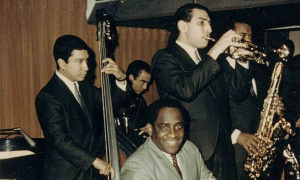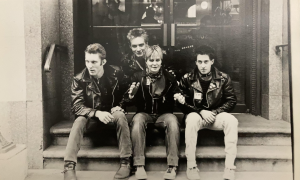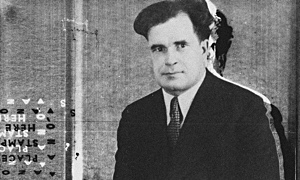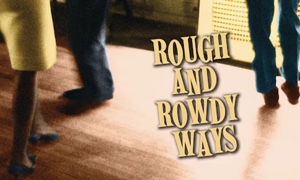Home » Jazz Articles » Hardly Strictly Jazz » Frank M. Young and David Lasky: The Carter Family - Don...
Frank M. Young and David Lasky: The Carter Family - Don't Forget This Song
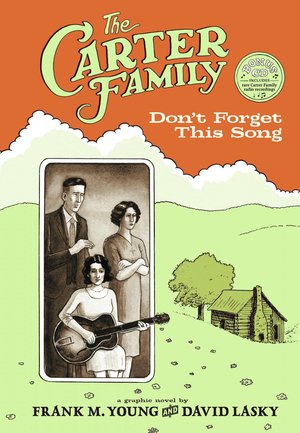 Frank M. Young and David Lasky
Frank M. Young and David Lasky The Carter Family: Don't Forget This Song
192 pages
ISBN 978081988361
Abrams ComicArts
2012
In recent years, the music biography has turned notable corners. The post-punk generation, coming largely from the world of fanzines and urban weekly newspapers, has become a big chunk of the literary establishment, and they've brought with their stylistic practices with them. Editorial expression, format, research procedures-new era.
There are obviously still compelling books to be written in the old style of traditional biographical narrative/scholarship. The One (Gotham, 2012), RJ Smith's biography of singer James Brown, is a fresh benchmark of that. He may even have established himself as the David McCullough of rock bios, if only for what he uncovered about the making of Brown's epoch-shattering Live At The Apollo (the first one). Actually, for much more. Smith's chapteristic literary style-which suits Brown-comes of a later editorial discipline than that which spawned writer slike David Halberstam, whose generation was more tome-oriented (see Robert Caro).
While there had been a few James Brown books, none of them were anywhere near as deep as The One. But the Carter Family had been definitively examined in Will You Miss Me When I'm Gone? (Simon and Schuster, 2002), a tome by Mark Zwonitzer and Charles Hirshberg, as well as a beautifully rendered 2005 PBS special as part of the American Experience series. It wouldn't seem that the story needed retelling.
Don't Forget This Song is the first major music biography written as a graphic novel. At 186 color pages, it is ambitious to its format.
It was just a matter of time.
In 2005, there was Charles Burns' Black Hole (Pantheon), a 368 page hardbound graphic novel that was received as a true novel and not just as a big comic book. While graphic novels had made it as far as live-action film-Dan Clowes' Ghost World being the hands-down favorite among record collectors-it was Burns who finally crossed the bridge from graphic novels to conventional literature. So, while short-form biographical music comics had long been part of things, this intends to be the first serious graphic music biography.
(For the record, there is a European Johnny Cash graphic novel, but it is not nor does it seek to be a serious biographical work.)
The Carter Family were a pivotal force in early country music, not just as a performing and recording group, but also as a kind of bridge between unfinished traditional mountain folksong and commercial country music. It was AP Carter who successfully collected and streamlined the old songs into formed, arranged structures that could not only be repertoire for his own group, but also teachable, transmittable songs that could take on a life for the masses beyond the mountains. When you hear "Will The Cirlce Be Unbroken," "Wildwood Flower" or dozens of other pre-war country classics, you're hearing the Carters' template in action. AP was to country music what WC Handy was to blues. His wife Sara Carter sang and played autoharp, and their cousin Maybelle Carter sang and played guitar. From the time they started recording in 1927 until they ground to a halt in 1943, they were hugely popular and influential. Their records are not just canonical-they continue on as templates. Sara and AP's harmonies are still lingua franca, and Maybelle's guitar style is now part of the genetic code for country musicians. Remove the Carter Family from the chain of development and much of country music (and therefore rock'n'roll) is inexplicable. Bear Family collected their commercial recordings into a mammoth box set (twelve discs), In The Shadow Of Clinch Mountain, and Arhoolie has issued radio performances the group did for border radio station XET, The Carter family On Border Radio. It would not be hyperbole to refer to this work as the molecular roots of commercial country music.
There is a certain temptation among cultural historians to deal with such things as if every small event of daily life leads directly to some iconic piece of work. And certainly AP Carter was preoccupied with musical posterity. Even with this disclaimer, Song's setting, supporting characters, and events are the stuff of great stories. Picture yourself in the Clinch Mountains of Virginia, depression era, and a car pulls up. A shaky, nervous guy-AP-gets out of the driver's side and asks if know any old songs and if you will sing them for us. From the passenger side comes Lesley Riddle, a one-legged African-American guitarist and singer whose job it was to help AP collect songs and teach them to Sara and Maybelle. Apocryphal though it sounds, this is how an unimpeachable catalog of southern music was pulled together over time.
The specter of Robert Crumb looms over any cartoonist/illustrator who deals with pre-war American vernacular music. It is his work that has for decades graced reissue album covers and compact disc booklets. He also has done series of trading cards each of early country, jazz, and blues musicians, and his influence on the anyone drawing this stuff in a comic book format is inescapable. However, David Lasky's drawing style avoids the blatantly imitative traps into which many others have marched pridefully. He has avoided the intense hyper-panel thing for which Crumb is so known and instead goes with something like an old Southern photo album/family tree for much of the layout, especially the more tangential parts of the story. Lasky's cover is designed like a thirties country music songbook (of "folio," as they were then called), and there's a relaxed quality to the drawings. Lasky has chosen quiet charm over density, which really helps stave off the fatigue that often comes with reading something that encompasses decades over almost two hundred pages. Also, his attention to period detail-especially with regard to guitars, microphones, record labels, sound reproduction devices (radios and record players)-is spot on. The visual style is perfectly matched to the southern period dialogue, and Lasky's ability to draw legends like Jimmie Rodgers in a comic style devoid of cartoonishness gives Song a healthy measure of visual dignity.
The Carters' story is something of a real life O Brother, Where Art Thou? It is courtship, betrayal, divorce, fame, travel, intolerance for racial injustice and more, largely in Biblical proportions. The supporting cast includes visionary record producer/song publisher Ralph Peer (who himself will soon be the subject of a big book by the humbling Barry Mazor), quack doctor John R. Brinkley (subject of Pope Brock's fantastic book Charlatan: America's Most Dangerous Huckster, the Man Who Pursued Him, and the Age of Flimflam, Crown, 2008), visionary Victor Records head Eli Oberstein, and, of course, the great Jimmie Rodgers. Frank M. Young's ability to write dialogue is the difference between life and death for a book of this nature, and he does a beautiful job. Similarly, his scholarship is clear-minded, non-presumptuous, and solidly gathered. Early country music too often brings out the revisionist historian in great writers, but Young has kept modesty at the fore. His version rings true. Like the great country music historian Charles Wolfe, he knows the difference between genuine empathy and self-serving earnestness wrapped in politically correct condescension. He lets the Carter's have their own pride without appointing himself to romanticize their bad days.
(No mean feat given AP's tragic nature.)
Song's pages end up with an enclosed eighteen minute CD of the Carter Family playing in 1939 on XET radio and gives us not just the sound of their music, but also window to their interaction and a tiny scent of their world.
This is not to suggest the graphic novel as the new standard format for biography, music or otherwise. The format is so intensely stylized, and too often the line between comic book and caricature is recognized only after it's too late, but Lasky and Young have established a discreet, tasteful balance between style and scholarship. In a year of unique historical music packages, Don't Forget This Song stands out.
< Previous
Riverloam Trio
Next >
Live at Kerrytown House
Comments
Tags
For the Love of Jazz
 All About Jazz has been a pillar of jazz since 1995, championing it as an art form and, more importantly, supporting the musicians who create it. Our enduring commitment has made "AAJ" one of the most culturally important websites of its kind, read by hundreds of thousands of fans, musicians and industry figures every month.
All About Jazz has been a pillar of jazz since 1995, championing it as an art form and, more importantly, supporting the musicians who create it. Our enduring commitment has made "AAJ" one of the most culturally important websites of its kind, read by hundreds of thousands of fans, musicians and industry figures every month.





